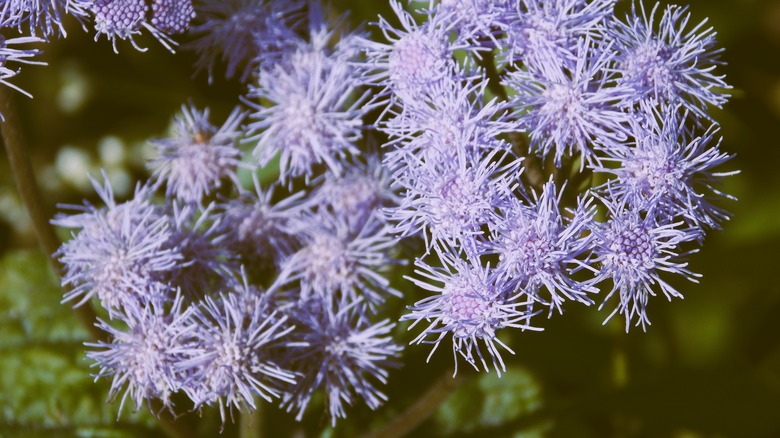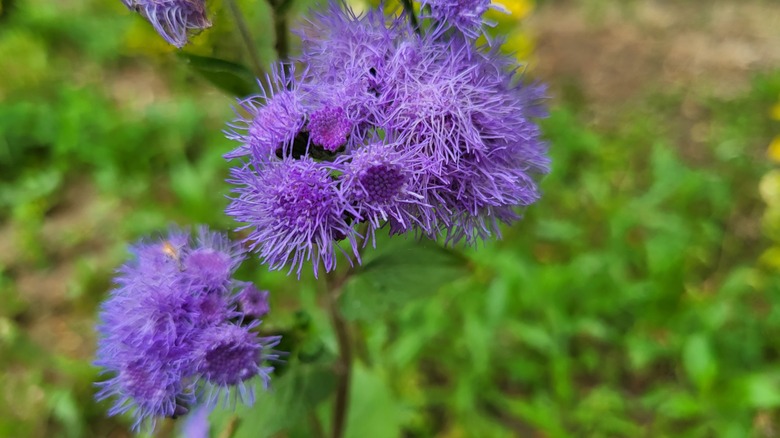Prevent Weeds From Growing In Your Garden By Planting This Pretty Blue Flower
Gardeners are constantly searching for effective, natural methods to control weeds. Alternative approaches to weed prevention include sugar, Coca-Cola and the trusted newspaper technique. However, a lesser-known, eco-friendly solution lies in using specific plants that naturally suppress weeds. One such plant is the blue mistflower, sometimes referred to as hardy ageratum, a resilient perennial native to North America. Known for its clusters of soft, bluish-purple flowers, blue mistflower not only adds beauty to your garden but also plays a crucial role in weed control. This plant thrives in a variety of soil conditions, making it an excellent choice for gardeners looking to reduce their reliance on chemical weed killers.
By planting blue mistflower strategically in your garden, you can take advantage of its dense foliage, which acts as a natural barrier against weeds. This plant is particularly useful in areas where weeds tend to be more aggressive, as it can outcompete them for essential resources like sunlight, water, and nutrients. Additionally, this flower attracts beneficial pollinators, such as butterflies and bees, which can further enhance the health and vitality of your garden.
The dual benefit of weed suppression and pollinator support makes blue mistflower a versatile and valuable addition to any garden, especially for those who prioritize natural gardening methods. As we explore the unique qualities of this blue flower, you'll discover why it is more than just a decorative plant — it's a practical, sustainable solution for maintaining a healthy, weed-free garden.
How blue mistflower suppresses weed growth
The blue mistflower is highly effective at suppressing weed growth due to its aggressive spreading nature and dense, ground-covering foliage. Once established, it forms a thick mat of leaves and stems that creates a natural mulch, shading the soil and depriving weeds of the sunlight they need to germinate. This dense coverage also helps to retain soil moisture, reducing the need for frequent watering while simultaneously creating an environment where weed seeds struggle to thrive.
The blue mistflower's ability to spread rapidly and cover large areas makes it particularly advantageous for gardeners dealing with stubborn, hard-to-control weeds. In addition to physically blocking weeds, blue mistflower competes directly with them for essential resources like water and nutrients. Its root system is efficient at extracting nutrients from the soil, leaving little for potential weed growth. This competition, combined with the plant's rapid expansion, significantly reduces the chances of weeds becoming established in areas dominated by blue mistflower. Furthermore, the flower's resilience in various soil types means it can be planted in a wide range of garden settings, from flower beds to borders and even in challenging areas under trees and shrubs.
The plant's late-summer bloom also provides a burst of color during a time when many other plants are fading, adding aesthetic value to its functional role as a weed suppressant. By integrating blue mistflower into your garden, you can reduce the need for labor-intensive weeding and create a more sustainable, low-maintenance landscape that naturally resists the intrusion of unwanted plants.
Maximizing the benefits of blue mistflower in your garden
To fully utilize the weed-suppressing abilities of blue mistflower, it's essential to understand how to plant and maintain it effectively. This plant thrives in conditions ranging from full sun to partial shade, making it adaptable to various garden environments. Although it prefers moist, well-drained soils, blue mistflower is also capable of tolerating poorer soil conditions, which makes it a versatile choice for different parts of your garden. When planting this stunning flower, it's important to choose locations where weeds are most problematic, such as along garden borders, walkways, or in open spaces that are prone to invasive growth.
Its ability to spread quickly ensures that these areas will be covered in no time, reducing the likelihood of weeds taking root. However, the very characteristic that makes blue mistflower so effective at weed suppression — its rapid growth — also means it can become invasive if not properly managed. Regular trimming and thinning are crucial to keeping the plant within its designated area. This maintenance is straightforward and involves cutting back the plant after it flowers to prevent it from spreading too aggressively. Another strategy for maximizing the benefits of this flower is to pair it with other ground-cover plants that have complementary growth habits. This not only enhances the aesthetic diversity of your garden but also strengthens the overall weed suppression by creating a multi-layered barrier against invasive species. Additionally, the flowers of blue mistflower provide late-season nectar for pollinators, further contributing to a healthy and thriving garden ecosystem.


